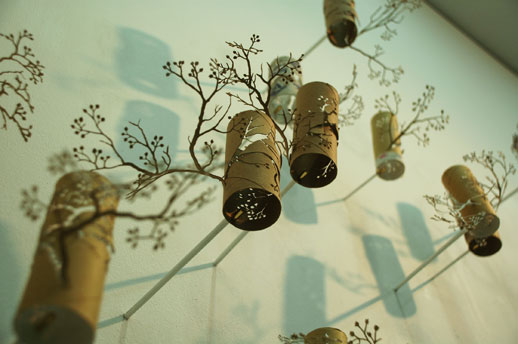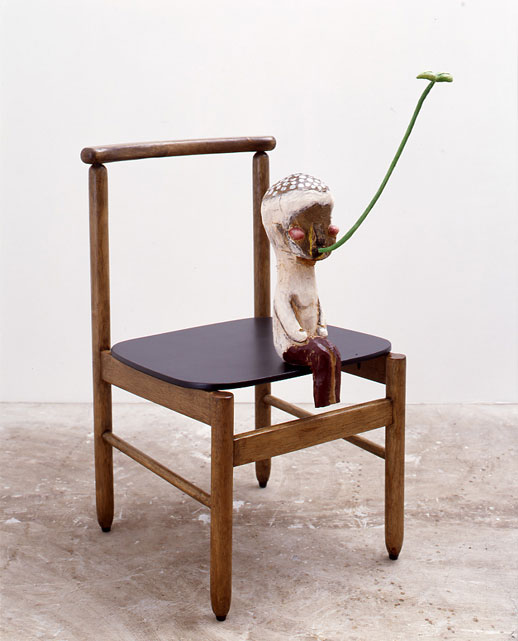A Forced Marriage of Award-winning Artists
Art Scope, an artists-in-residence exchange program established in 1991 by the Daimler Foundation, creates the opportunity each year for select Japanese and German artists to temporarily work and live in one another’s great capital cities — Tokyo and Berlin. In partnership with Art Scope, the Hara Museum of Contemporary Art is showing the work of the program’s 2007/2008 participants — Izumi Kato and Yuken Teruya of Japan, and Eve Teppe and Ascan Pinckernelle of Germany.

As it’s a showcase for an international exchange program, before visiting the Hara, I anticipated that I might discern some trace of the artists’ experiences abroad in their (mostly) new work now on view. But this supposition soon proved rather silly. Other than some translated text, there’s nothing particularly Germanic in the Japanese artists’ new work, and nothing noticeably Japanesey in the Germans.’ And nor should there be, necessarily.
Another potential pre-show pitfall: The organizers of Art Scope selected the participants on the basis of individual merit, without a curatorial concept in mind for the culminating group exhibition. Having come to be co-exhibitors only by coincidence, the artists have little in common. An accidental constellation can often make for as compelling a picture as any carefully arranged assemblage; but in this case — despite the curator’s lofty claims to the contrary — there is no evocative intra-group resonance to be heard. In the packaging of the show, the curatorial rhetoric has been stretched to a point of near vacuity (for what visual work isn’t a “Face of Existence” in some sense; and what exhibition doesn’t give us “a hint of the many possibilities that lie hidden in the act of creation and the experience of viewing?”). This post-facto curatorial overstepping, slight as it may be, creates distracting preconceptions and does both the artists and audience a small disservice. With a grab-bag exhibition of this scale, it would be better to just explain the nature of the underlying institutional program (while giving the donors their due name placement), and let the award-winning art speak for itself.
The first piece you are likely to encounter is the best of the exhibition. Inhabiting a tall, glass-covered display case, between the museum’s front doors and ticket desk, is Yuken Teruya’s Dawn (Seven Forests). Seven traditional Japanese cooking knives have been stabbed into the case. From the handle of each knife hangs the fragile, papery pod of a recently vacated chrysalis. All about the box, the hatchlings, beautiful rice paper butterflies, alight, land and flutter. Natural beauty most delicate and ephemeral, cultural tradition most exquisite and durable, here together in storybook collusion: Teruya has encased the scene of dreams and wonder.

All of Teruya’s new work gives this sense of nature brought to life, speaking gentle words of dreamy poignancy. In a room nearby, pine twigs in the shapes of letters sprout from the upper reaches of the walls, forming a short text which reads, “Cut down my trunk and make a boat. Then you can sail away,” an excerpt from Shel Silverstein’s classic children’s book, The Giving Tree. Below, an iconic ring-shaped life-preserver hangs from a metal pole, its rope running in a lazy circle around the room. Titled, Touch a Port and Help Yourself, respectively, these works nudge us away from the gallery’s shores and cast us gently, dreamily, out to sea.
In a series of oil paintings and wooden sculptures, Izumi Kato depicts a little family of enigmatic, bi-pedal beings. Kato’s figures partake of the ancient Egyptian, tribal African, the fetal, the fantastic, the totemic, the nymph-like, and extraterrestrial, without being neatly reducible to any one figurative tradition. The mother figure often sprouts a flower from her mouth or pubis, the father issues a long-stalked leaf sprout, the young son a sprightly bud. Their multi-pupiled eyes prevent any mammalian mutual recognition and make them hard to identify as fellow sentient beings; instead, these astral eyes lend them some inscrutable vatic character. The biggest sculpture sits in a large-windowed, ovular alcove. With this piece Kato has cast the father in the form of a centaur, and the mother and son perch cutely on his back. Against the lush backdrop of the Hara’s verdant summer gardens, Kato’s primordial figurines are most seductive here, in what is easy to imagine as their magical natural habitat.
![Courtesy of the artist Eva Teppe, 'The World is Everything that is the Case' (2003) [Still from video]](http://www.tokyoartbeat.com/tablog/entries.en/wp-content/uploads/2008/08/artscope2008_3.jpg)
Eve Teppe uses fragments of found film footage, often from her own family’s old home movies, to make haunting slow-motion videos. With Omertà, the better of her two new works, five video monitors are arranged against the blackened back wall of a dark room. A person occupies the frame of each monitor, cropped at the shoulders, as in a portrait, and seeming to hover in space. The faces are dour, of singularly mordant miens. As an ominous Lynch-ian sound-track rises and falls, the portraits intermittently awaken, slowly opening their eyes to shoot sinister, almost accusatory, stares at the viewer. The title, Omertà, refers to the “code of silence,” commonly attributed to the Sicilian mafia, which dictates that one must never speak nor cooperate with state authorities. Among mobsters, breaking Omertà warrants the death sentence. Sitting opposite the faces, a viewing bench is gently illumed by two recessed spotlights. Otherwise the room is pitch-black. Sitting there in the dim light, under the cruelly ferrous eyes of the portraits, I felt uncannily vulnerable, as if I were the one on display. Did I break the code? Am I one of the authorities? Or have the portraits violated their oath of silence, by coming alive and daring us to rebuke them?
Ascan Pinckernelle, besides having a bad-ass name, makes flawless two-point perspective pencil and ink drawings of modest modern architectures. Floating in space against blank backgrounds, these fine drawings recommend themselves as the Platonic ideal forms of bland little buildings.
From a well-established, mid-sized contemporary art museum such as the Hara, one might reasonably hope for a more daring season of scheduling than an exchange program awards show; but that’s not to say the work itself isn’t good. It is. And for après-art, down on the ground floor, the museum cafe serves tea, cake and cold beer. Wrapped around a virid little garden, with art-store ambient music worrying the air, white tables and a wall of windows – it’s the perfect place for a late-summer date. Choose your company for a lovely Sunday.
Patrick Brzeski
Patrick Brzeski



